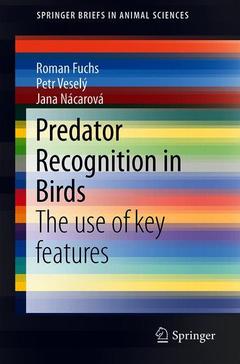Predator Recognition in Birds, 1st ed. 2019 The Use of Key Features SpringerBriefs in Animal Sciences Series
Auteurs : Fuchs Roman, Veselý Petr, Nácarová Jana

Provides a concise overview on avian predator recognition
Discusses both ethological and cognitive approaches
Describes in detail the use of key factors to recognize predators
Date de parution : 04-2019
Ouvrage de 117 p.
15.5x23.5 cm
Disponible chez l'éditeur (délai d'approvisionnement : 15 jours).
Prix indicatif 52,74 €
Ajouter au panierThèmes de Predator Recognition in Birds :
Mots-clés :
avian predator; behaviour; bird cognition and memory; bird ethology; ornithology; prey reaction



